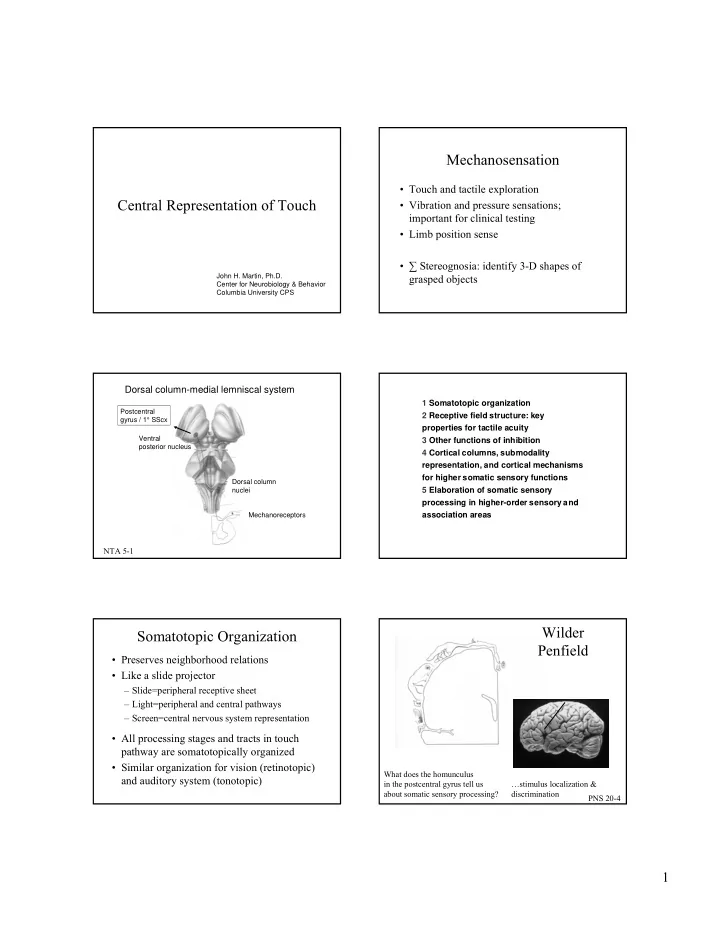

Mechanosensation • Touch and tactile exploration Central Representation of Touch • Vibration and pressure sensations; important for clinical testing • Limb position sense • ∑ Stereognosia: identify 3-D shapes of grasped objects John H. Martin, Ph.D. Center for Neurobiology & Behavior Columbia University CPS Dorsal column-medial lemniscal system 1 Somatotopic organization Postcentral 2 Receptive field structure: key gyrus / 1° SScx properties for tactile acuity Ventral 3 Other functions of inhibition posterior nucleus 4 Cortical columns, submodality representation, and cortical mechanisms for higher somatic sensory functions Dorsal column 5 Elaboration of somatic sensory nuclei processing in higher-order sensory and association areas Mechanoreceptors NTA 5-1 Wilder Somatotopic Organization Penfield • Preserves neighborhood relations • Like a slide projector – Slide=peripheral receptive sheet – Light=peripheral and central pathways – Screen=central nervous system representation • All processing stages and tracts in touch pathway are somatotopically organized • Similar organization for vision (retinotopic) What does the homunculus and auditory system (tonotopic) in the postcentral gyrus tell us …stimulus localization & about somatic sensory processing? discrimination PNS 20-4 1
2 Point Discrimination CNS neurons have receptive fields Good Poor What is the basis of distortions in the cortical homunculus? …receptive field structure Convergence: CNS receptive fields >> PNS receptive fields PNS 22-5 Receptor innervation density increases Receptor innervation density increases from proximal to distal from proximal to distal CNSreceptive field size CNSreceptive field size decreases from decreases from proximal � distal proximal � distal and and overlap overlap Representational area increases increases inversely proportional to RF area Map distortions reflect genetics and experience PNS 20-5 2
Receptive field •Somatotopic organization Primary sensory neuron RF •Receptive field structure: key properties for tactile acuity •Other functions of inhibition •Cortical columns, submodality CNS neuron RF representation, and cortical mechanisms for higher somatic sensory functions •Elaboration of somatic sensory Structural basis of RF: distribution of sensory processing in higher-order sensory and fiber innervation association areas PNS 23-10 Gradient of excitation within Gradient of excitation effectively excitatory RF in CNS neurons reduces RF size to center …RF area increases with stronger stimuli; not veridical Receptive field structure Primary sensory neuron RF CNS neuron RF Inhibitory RF Inhibitory interneuron Background neural activity drops Excitatory RF Increase signal-to-noise ratio PNS 23-10 3
Mechanoreceptor response CNS neuron response to stimulus Receptive Field Structure Other uses for inhibition in sensory systems: • Gradient of + sharpens neural response to Stimulus feature extraction center of RF, which is most sensitive • Inhibitory RF turns neuron off before it is activated by stimulus, thereby increasing S/N Other uses for inhibition in sensory systems: Distal inhibition--usually top down How is information from Cortical neuron excites different mechanoreceptors inhibitory interneuron represented in primary somatic Inhibitory interneuron + inhibits projection neuron sensory cortex? - in nucleus Effect: reduces transmission through nucleus FINE TUNE 4
Rapid adaptation Slow adaptation Mechanoreceptors Meissner Merkel Slowly adapting Meissner Pacinian Pacinian Ruffini PNS 22-3 Time Texture code: • Cell-stained section (Nissl) • most 6 cell layers • Different receptors respond to different components of complex stimulus • Internal representation of a texture determined by activity in population of diverse mechanoreceptors How is receptor information represented in the primary somatic sensory cortex? Pyramidal neuron: projection neuron Layer 1 Layer 1 Layers 2 & 3 Layers 2 & 3 Layer 4 Layer 4 Stellate Neuron: interneuron Layer 5 Layer 5 Layer 6 Layer 6 RA-Meissner SA-Ruffini RA-Meissner SA-Merkel RA-Pacinian •neuron density varies Columnar organization Different textures produce different •same receptor column activation patterns •same location 5
Columnar Body representation w/in organization each cytoarchitectonic area of 1° SScx 1 To other cortical areas 2 Input from Thalamus 3 To Brain stem, spinal cord, basal ganglia 4 Back to thalamus 5 6 1 2, 3 4 5 PNS 23-6,7 PNS 20-6 6 Processing mechanoreceptive information Processing mechanoreceptive information within the Primary Somatic Sensory Cortex within the Primary Somatic Sensory Cortex Posterior parietal cortex, Deep insular cortex, Deep motor cortex Area 3a Area 3a Ventral posterior --- nucleus “top down control” Area 3b Area 3b Area 1 Area 1 Area 2 Area 2 Cutaneous Cutaneous Integrated representation: ?stereognosia Summary Conclusions • Bottom up • Touch path has hierarchical organization – Receptors to spinal cord to cortex – Not bucket brigade • Top down – Message transformed – Cortex to subcortical centers - Layers 5, 6 • Several mechanisms for enhancing spatial acuity – Other cortical areas project into somatic sensory cortex – Gradient of excitation • Result – Surround inhibition – Experience and expectation modulates stimulus • Columnar organization of cortex processing, both subcortically in relay nuclei and in – Same input (receptor and location) cortex • Intracortical processing leads to integrated • illusions representation – Pathological states can generate sensation de novo • halucinations 6
7
Recommend
More recommend